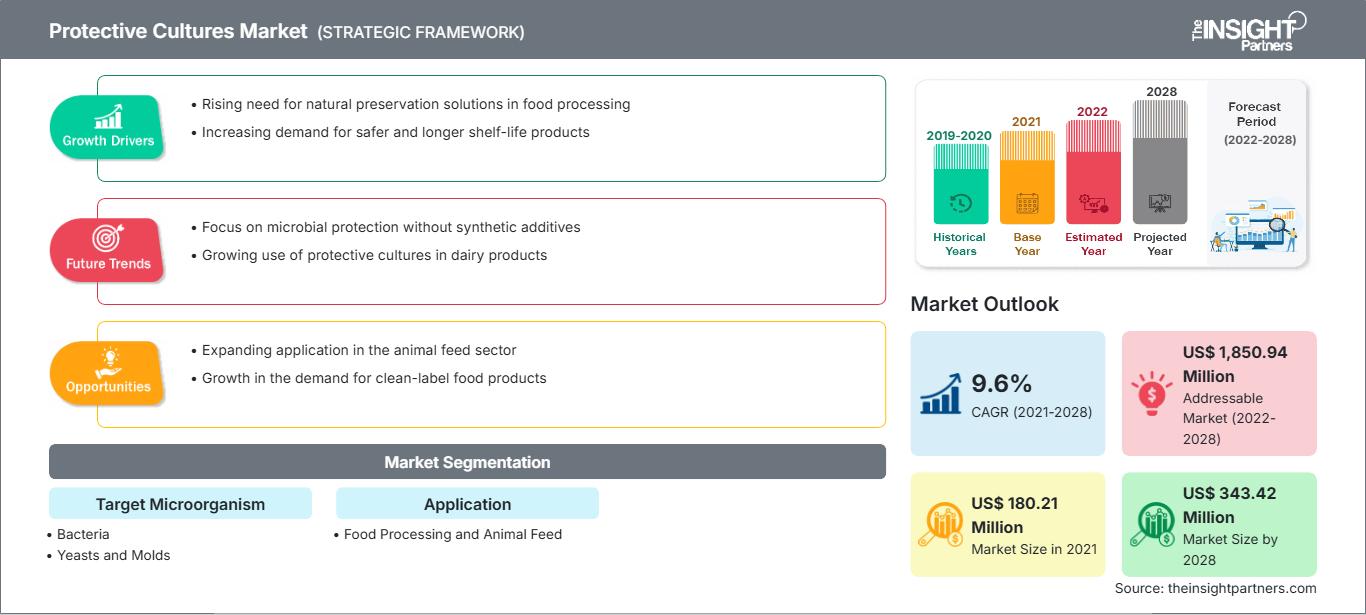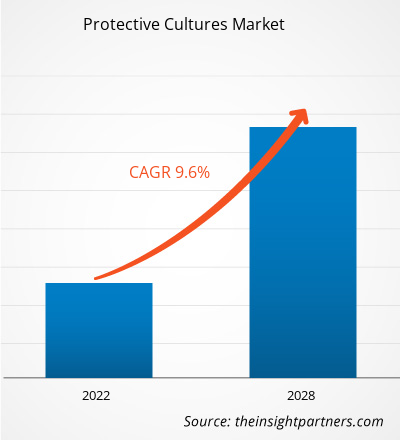[研究报告]保护性菌种市场预计将从 2021 年的 1.8021 亿美元增长到 2028 年的 3.4342 亿美元;预计 2021 年至 2028 年的复合年增长率为 9.6%。
全球对天然和无化学防腐剂产品的需求不断增长,以及对延长保质期的易腐产品的需求不断增长,推动了保护性菌种市场的增长。
预计在预测期内,亚太地区的保护性菌种市场将以最高的复合年增长率增长。中国是最重要的乳制品市场,主要受乳制品消费量增长的驱动。对天然零食、酸奶和酸奶等发酵乳制品等乳制品的需求不断增长,加上产品和包装创新,正在推动亚太地区乳制品市场的增长。因此,预计未来几年,由于乳制品消费量的增加以及保护性菌种的诸多益处(例如抑制致病和腐败微生物生长的能力),保护性菌种市场将出现显著增长。此外,亚洲民众对天然和清洁标签产品的认知度不断提高,也有助于市场扩张。
自定义此报告以满足您的要求
您将免费获得任何报告的定制,包括本报告的部分内容,或国家级分析、Excel 数据包,以及为初创企业和大学提供超值优惠和折扣
保护性文化市场: 战略洞察

-
获取本报告的主要市场趋势。这个免费样本将包括数据分析,从市场趋势到估计和预测。
COVID-19 疫情对保护性培养物市场的影响
持续的 COVID-19 疫情对保护性培养物市场产生了相对积极的影响。这场疫情有助于培养人们对微生物培养物的兴趣和认识。这场危机对全世界大多数人来说都是一段令人不快且充满压力的时期。因此,世界各地的人们都开始消费清洁标签产品。COVID-19 疫情爆发后,人们对食物变得更加谨慎,并且比平时饮食更健康。COVID-19 疫情改变了消费者对清洁标签或产品以外的其他概念的看法。消费者继续关注居家和外出购物的清洁标签,这增加了清洁标签在各种食品中的应用。此外,大多数国家对2021年的经济发展前景持乐观态度。
市场洞察
乳制品消费量不断增长
全球乳制品市场正在蓬勃发展。消费者更青睐成分表更精简、产品标签更透明、更有益于健康的天然可持续乳制品。随着现代生活节奏的加快,人们对方便快捷、无需冷藏即可随时食用的乳制品的需求日益增长。保护性菌种对于乳制品制造商而言至关重要,因为它可以避免产品在保质期内变质,从而满足消费者对天然和清洁标签产品的需求,从而提高盈利能力。此外,酸奶、黄油和奶酪等乳制品的消费量在全球范围内呈激增之势。
奶酪已成为全球消费者日常饮食的重要组成部分。根据美国农业部的数据,2017年美国奶酪产量为5,733公吨,北美人均每年消费约6,626公吨奶酪。由于使用专门针对李斯特菌的保护性培养物,奶酪市场也是保护性培养物的主要终端用户之一。这种培养物由植物乳杆菌制成,能够有效防止李斯特菌在高风险的红色涂片表面成熟奶酪上形成。因此,上述因素推动了保护性培养物市场对奶酪的需求。此外,杜邦丹尼斯克和科汉森等公司凭借广泛的乳制品保护性培养物,在乳制品市场占有重要地位。随着人们对天然健康乳制品的需求不断增长,清洁标签和绿色标签产品在乳制品行业的需求也日益增长。
目标微生物洞察
根据目标微生物,保护性培养物市场可分为细菌、酵母菌和霉菌。酵母和霉菌细分市场在2020年占据了更大的市场份额。酵母是真菌的一个亚群,真菌是一大类生物,其中还包括霉菌和蘑菇。它们通常是单细胞生物,进化到可以在特定环境中生存。酵母通常寄生在高盐或高糖的食物上,例如泡菜、枫糖浆等,这会导致食物变质。低pH值的水果和液体也是酵母的目标,有些酵母会在肉类和奶酪的表面生长。霉菌由数百万个微小细胞组成,这些细胞相互连接形成链状,常见于面包、水果、湿纸和其他表面。它们会破坏干粮、咸鱼、水果、果冻、面包、泡菜、果酱和其他类似产品。
应用洞察
根据应用,保护性菌种市场分为食品加工和动物饲料两大领域。 2020年,食品加工领域占据了更大的市场份额,而动物饲料领域预计在预测期内将实现更高的复合年增长率。食品加工涵盖乳制品、饮料、肉类、家禽和海鲜产品等多个行业。保护性菌种的使用日益增多,尤其是在乳制品、肉类和海鲜行业,因为它们通常被认为是安全的(GRAS),并且天然存在于许多食品的微生物群中。此外,由于需要更长的保质期,食品加工商越来越多地使用保护性菌种。此外,消费者也开始意识到,大量的食物浪费是由于腐败和霉菌生长造成的。这也影响了食品加工商的盈利能力;因此,加工商使用保护性菌种来减少食物浪费。因此,食品行业对这些产品的需求正在增长。保护性菌种对于帮助乳制品生产商改进产品至关重要,因为它可以避免产品在保质期内变质,延长保质期,同时满足消费者对天然和清洁产品的需求。
保护性菌种市场的一些参与者包括 Biochem Srl、Bioprox、Chr. Hansen Holding A/S、Meat Cracks Technologie GmbH、DSM、Lallemand Inc.、International Flavors & Fragrances Inc.、Kerry Group、Sacco System 和 Dalton Biotechnologies Srl。主要公司采用并购、研发等策略来扩大客户群,并在全球市场上获得显著份额,这也使他们能够在全球范围内维护自己的品牌名称。
保护性文化市场区域洞察
The Insight Partners 的分析师已详尽阐述了预测期内影响保护性培养物市场的区域趋势和因素。本节还讨论了北美、欧洲、亚太地区、中东和非洲以及南美和中美洲的保护性培养物市场细分和地域分布。
保护性文化市场报告范围
| 报告属性 | 细节 |
|---|---|
| 市场规模 2021 | US$ 180.21 Million |
| 市场规模 2028 | US$ 343.42 Million |
| 全球复合年增长率 (2021 - 2028) | 9.6% |
| 历史数据 | 2019-2020 |
| 预测期 | 2022-2028 |
| 涵盖的领域 |
By 目标微生物
|
| 覆盖地区和国家 |
北美
|
| 市场领导者和主要公司简介 |
|
保护性文化市场参与者密度:了解其对商业动态的影响
由于消费者偏好的不断变化、技术进步以及对产品优势的认知度不断提高等因素,终端用户的需求不断增长,保护性菌种市场正在快速增长。随着需求的增长,企业正在扩展产品线,不断创新以满足消费者需求,并利用新兴趋势,从而进一步推动市场增长。

- 获取 保护性文化市场 主要参与者概述
报告重点
- 保护性培养市场中的渐进式行业趋势,帮助参与者制定有效的长期战略
- 发达市场和发展中市场采用的业务增长战略
- 2019 年至 2028 年保护性培养市场的定量分析
- 全球保护性培养需求估计
- 波特五力分析
- 了解竞争激烈的市场形势的最新发展
- 市场趋势和前景以及推动和抑制保护性培养市场增长的因素
- 通过强调支撑商业利益的市场策略来协助决策过程,从而促进市场增长
- 不同节点的保护性培养市场规模
- 市场以及保护性培养行业的详细概述和细分
- 各地区保护性培养物市场规模及增长机会
保护性培养物市场 — 按目标微生物
- 细菌
- 酵母和霉菌
保护性培养物市场 — 按应用
- 食品加工
- 乳制品
- 饮料
- 肉类、家禽和海鲜产品
- 其他
- 动物饲料
公司简介
- Biochem Srl
- Bioprox
- Chr. Hansen Holding A/S
- Meat Cracks Technologie GmbH
- 帝斯曼
- Lallemand Inc.
- 国际调味品和调味品公司Fragrances Inc.
- 凯里集团
- Sacco System
- Dalton Biotechnologies Srl
- 历史分析(2 年)、基准年、预测(7 年)及复合年增长率
- PEST和SWOT分析
- 市场规模、价值/数量 - 全球、区域、国家
- 行业和竞争格局
- Excel 数据集
近期报告
客户评价
购买理由
- 明智的决策
- 了解市场动态
- 竞争分析
- 客户洞察
- 市场预测
- 风险规避
- 战略规划
- 投资论证
- 识别新兴市场
- 优化营销策略
- 提升运营效率
- 顺应监管趋势






















 获取免费样品 - 保护性文化市场
获取免费样品 - 保护性文化市场